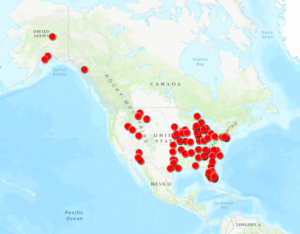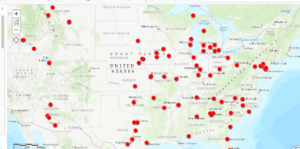I didn’t do a mapping project. I started out thinking I wouldn’t do a mapping project, and ended up not doing one, but in between those two states, I spent a lot of time thinking about a mapping project. Thus, I don’t have a map, but I thought I’d share what I do have in case people are interested — please let me know if this is out of bounds. (In case this is weird to Matt and Stephen: I’m definitely doing a network analysis later, so this doesn’t need to “count.”)
The assignment suggested a novel, and after thinking about it for a bit, the novel that came to mind was Octavia Butler’s time-travel novel Kindred. It was short enough that I thought I might be able to look through it again and find all the places, and the role of place is really important in the work. For those who haven’t read it, Kindred is a time-travel novel about American history. In it, an African American woman named Dana is repeatedly drawn back through time to the assistance of her ancestor, Rufus, a white son of a slaveholder, and eventually a slaveholder himself. Because Dana is brought back through time against her will, not to her own benefit but for the sake of a white person, and with no way out except through near-death experiences, her journeys are a metaphorical mirror for slavery — but she is also very literally made a slave at these times.
As you may imagine, place and time are central in the novel, which relies heavily on the difference between “here” (Maryland in the ante bellum South) and “home” (Los Angeles, 1976) — a difference in both space and time.
I needed a way to keep track of all the places mentioned in the novel, so I found myself doing what I eventually recognized as a deformance! I read through the book and made a note of each time that a place was mentioned.
It turns out that this is not quite as easy as it sounds. Ramsay’s point about a computer being able to do a deformance more completely and consistently than a human is well-taken, even for a work of medium length (in this case, a 300-word novel). I started out wanting to be quite literal about what did and didn’t qualify as a place — hoping to identify only places that could theoretically be identified on a sufficiently detailed map, at least with the aid of the context provided in the novel. This became difficult and ambiguous almost immediately, but I tried throughout to stick to a few rules:
- I would count physical places, but not experiences or metaphors. I did include Hell and Heaven when they were treated as places
- Places that are mentioned but not visited count
- Where someone is in relation to an object (or at any rate a small object) is not a place
- A person is not a place, even if they seem like one grammatically
As the novel went on, I found that I really needed to include the domestic spaces that make up so much of Dana’s experience, but I tried not to include where people were in relation to furniture. I made an exception for furniture large enough for a person to go into, like a bed or a bathtub. I’m not completely sure this makes sense when I’m excluding desks and fireplaces…
In any case, I thought I’d share one of the more interesting chapters. This is from section 6 of “The Fight.” In this section, Dana asks what happened to her husband Kevin, who she brought back with her to the past and accidentally left there. Additionally, Rufus finds a history book that Dana brought back with her from the future. Dana, after some reflection on the possible ramifications of his having it, takes it away and later burns it. This section includes more references to places outside Dana’s experience, though many of them are close to the plantation on which she finds herself. When the narrative mentions Talbot County, Dorchester County, and Southampton, Virginia, Dana is thinking of Frederick Douglass, Harriet Tubman, and Nat Turner. So my deformance looked a little like this:
Baltimore
beside his bed
home
Pennsylvania
where Kevin was
that river
at that river
home
home
Philadelphia
At home
New York
Boston
Boston
Maine
north
West
Maine
Maine
the cookhouse
out here
out of the house
Baltimore
there
there
there
New Orleans
New Orleans
down there
Louisiana
in the cane fields
California
In town
Maryland
Louisiana
slave states
here
where he is
North
onto his bed
New York
South
Maryland
Talbot County
Dorchester County
Eastern Shore
Southampton, Virginia
Maryland
Virginia
to town
the plantation
on the place
Boston
home
You can see the rest of it online. (Apologies for the inconsistent capitalization — I worked on two different devices, one of which automatically capitalized the beginning of each cell, and I haven’t had the chance to clean it up.)
In any case, even though it didn’t result in a map, this showed me a lot about the book. I noticed the contrast between “here” and “home” and the often slightly euphemistic feeling of the word “here;” it refers to the plantation, the time period, the condition of slavery altogether. I also noticed how, in the plantation chapters, the focus on domestic spaces creates this sense of a closed world in which movement is limited and the same few places come up again and again. “Town” (Easton, Maryland) seems no nearer than Boston — neither is really available as a travel destination.
Of course, if I were doing this for a more serious purpose, it would be necessary to go back over and look for things I’ve missed or wrongly included. Ultimately, I think this would be a great job for TEI, which does allow places to be encoded as such in metadata — but encoding an entire novel is far beyond my capabilities at this point.
In any case, I definitely chose too big a project for this assignment and didn’t have time to actually work with maps, but I still think this novel is a good one for mapping. As I worked through the readings for this week, it provided a focal point from which I could think about the relationship between time and place that Presner describes, and the thick relationships between immediate, personal reality and the larger political and economic systems that Ayers insists on, and I’m still thinking about how those could be visually represented. Layers for time periods? Maybe, but also maybe layers for the slavery laws at the different times that Dana visits, or a layer showing the sites of resistance with the rebellions and escape routes referenced in this chapter. Or maybe layers based on scale– the relationship between tiny domestic spaces and grander concepts of cities and states is really important in this novel, because Dana is aware of other places and often speaks or thinks about them, but cannot access them. Instead, most of the actual action of the novel takes places on a much smaller scale (and to some extent I realize this is true in every novel, but it’s thematically important in this one). There’s a lot here, and I’m sorry I couldn’t have this map available for everyone because in my mind there’s a lot that could be done with it. (I really struggled with ArcGIS and played around with GoogleMaps some.)






